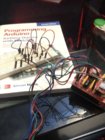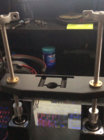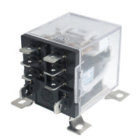I had a similar problem that took me ages to fix. I eventually found a loose connection on the shunt for the volt/amp meter. This was after confirming all of the work I did first including each and every solder joint, tightening each screw, etc. I assumed that my work was most probably the one to be faulty rather than the purchased equipment. I was correct. I also recommend separating your 12V and 48+V wires as you can get some problems from bunching significantly different voltages together.
I now do an empty power level test before each annealing session to ensure it is constantly in the same area and I record that each time. There is a photo of my volt/amp meter on the previous page -78. My annealer runs 48V at 10.7A and 420 watts with an empty coil. That increases when a cases is dropped, but each caliber and each brand of brass within each caliber is different metal composition, so the times to anneal are also different. My 6.5 Creedmoor Lapua brass takes 7.8secs, 223 Remington brass 4.1s, 223 Lapua brass 4.8s, 22-250 Hornady brass 5.4. I do the first four cases and last two cases of each session with Tempilaq 750 and they are all good at those times.
Hope you find your problem.
I now do an empty power level test before each annealing session to ensure it is constantly in the same area and I record that each time. There is a photo of my volt/amp meter on the previous page -78. My annealer runs 48V at 10.7A and 420 watts with an empty coil. That increases when a cases is dropped, but each caliber and each brand of brass within each caliber is different metal composition, so the times to anneal are also different. My 6.5 Creedmoor Lapua brass takes 7.8secs, 223 Remington brass 4.1s, 223 Lapua brass 4.8s, 22-250 Hornady brass 5.4. I do the first four cases and last two cases of each session with Tempilaq 750 and they are all good at those times.
Hope you find your problem.














